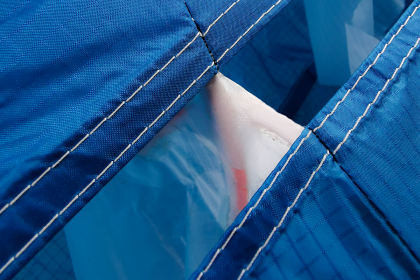
An article from Cross Country Magazine with some insights from our designers on:
WHY CELL OPENINGS ARE SHRINKING
Higher performance wings generally look racier on the ground, but one of the outliers is the Triple Seven Rook 3 (high EN B) which sports incredibly narrow cell openings in comparison to most wings — including the EN D two-liner it is photographed with here. In December we posted this image to our social media pages and asked pilots to “guess the gliders’: Afterwards, we talked to Triple Seven designer Aljaz Vatic about it.
Aljaz, the cell openings seem very narrow on Rook 3. They are less than half the width of the two-liner we compared it with! How wide is the cell opening at the centre of Rook 3? Do they vary by size? With the Rook 3 MS, the cell opening should be about 30mm in the centre of the canopy. The size of the cell openings varies with the sizes of the glider. The cubic metres of air in the canopy relate to the possible size of the cell opening, so smaller wings will have a smaller cell opening.
How did you manage to get the openings so narrow? Surely you need wider openings to get enough air intake? The size of the opening is a correlation between several design aspects combined. First, of course, is the right position for it. At Triple Seven, we’ve done a significant share of research on the positioning and shaping of the openings on many different profiles. We implemented the BPI [back positioned intake, Triple Seven’s name for a sharknose design] in the EN-A and B class early, so we have quite some mileage now with this technology and feel confident with the art of designing and positioning of it.
Another aspect is the cubic-metre space in the canopy, or to say the volume of air in it. More technically-minded pilots will notice that our latest wings implement a relatively low thickness profile, which brings benefits in performance and safety. The thinner profile, of course, also equals smaller air cubature [volume] in the canopy. This ratio means it’s possible to have narrower cell openings. The design still needs to allow the canopy to maintain the significant pressure through the full speed range, which we can only achieve with the right “positioning” of the intake. We have a lot of experience in this now, so it works successfully across the full range of EN standards,
Tell us about how the sharknose technology has evolved through the Rook series? Of course, the technology always develops. The core of designing is testing new things, and that is what keeps us addicted to this work. The BPI has developed a lot since our first take on Rook 1. The overall construction of the opening has changed, as well as the shape of it as we see with the Rook 3. It all correlates with the change in the profiles of the wings. In such a process every change in one part of the package creates a cascade of differences in other parts of the wing. If you can orchestrate and tune those in harmony, then you end up with a product that pilots will like and be able to use the full potential of.






